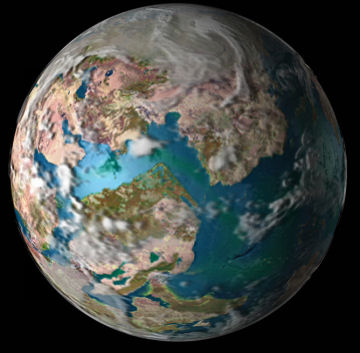Dusty Clues: Study suggests no dearth of Earths
Supposedly, there’s no place like home. But a new study suggests that earthlike planets orbit or are forming around many, if not most, nearby sunlike stars, providing places where life might have gained a foothold.

That conclusion comes from an infrared survey of some 300 stars similar in mass to the sun and ranging in age from a youthful 3 million years to a middle-aged 3 billion. Using NASA’s Spitzer Space Telescope, Mike Meyer of the University of Arizona in Tucson and his colleagues surveyed those stars and their surroundings at an infrared wavelength of 24 µm. In many cases more radiation was emitted than the stars themselves could have produced, indicating the presence of dust. That may in turn be a sign of possible terrestrial planet formation, Meyer and his colleagues, including Lynne Hillenbrand and John Carpenter of the California Institute of Technology in Pasadena, argue in the Feb. 1 Astrophysical Journal Letters.
Dust, along with gas and ice, exists in the disks that form around newborn stars. Those materials gradually coalesce into large clumps that stick together to form planets, asteroids, and comets, and in the process the original disks disappear. Around older stars, however, dust can be generated by rocky bodies—fledgling planets or asteroids—crashing into each other. In either case, the dust absorbs visible and ultraviolet light from its parent star and reradiates it at infrared wavelengths.
The infrared radiation recorded by Spitzer indicates that most of the dust is warm, with a temperature of some 100 to 300 kelvins. In our solar system, that temperature range corresponds to a location anywhere from Earth’s distance from the sun to that of Saturn. That includes the inner solar system’s asteroid belt.
About 10 percent of the sunlike stars examined by Meyer’s team have dust radiating at 24 µm. Because a system with forming or mature planets may not emit strongly at 24 µm throughout its life, the fraction of stars with planets could be higher than 10 percent. In fact, the researchers estimate that up to 62 percent of the surveyed systems could have planet-making material in their inner regions, where any water present might remain liquid.
“Meyer’s result is exciting confirmation that around many other stars like our sun, the region analogous to our own asteroid belt is full of solid material, possibly related to past or present planet formation,” comments Caltech astronomer Charles Beichman, who is not a member of the team. The finding “is a good sign that the basic stuff of planetary systems is widespread.”
The numbers calculated by Meyer and his colleagues “are still pretty soft” but jibe with the notion that it is easier to make rocky planets like Earth than gas giants like Jupiter, says theorist Alan Boss of the Carnegie Institution of Washington (D.C.).
According to a leading model, rocky cores coalesce first. To make a Jupiter, the core then has only about 10 million years to snare vast amounts of gas from the planet-forming disk before that structure disappears. In contrast, to form a terrestrial planet, the rocky core need grow only to about the size of Earth’s moon before the disk vanishes. The core can then leisurely accumulate bits of leftover rock and dust to build up to a body as large as Mars or Earth, says Boss.
Although the Spitzer findings are tantalizing, Meyer notes that proof of terrestrial exoplanets awaits the launch next year of the Kepler mission, which will search for such orbs by the tiny dip in starlight they induce each time they pass in front of their parent stars.







